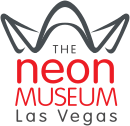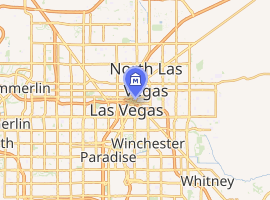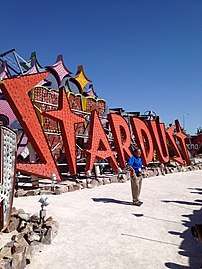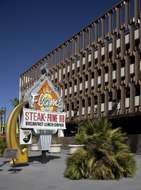Neon Museum
The Neon Museum in Las Vegas, Nevada, United States, features signs from old casinos and other businesses displayed outdoors on 2.62 acres. The museum features a restored lobby shell from the defunct La Concha Motel as its visitor center, which officially opened on October 27, 2012.[2]
 | |
.jpg) Neon Museum Visitor Center | |

| |
| Established | 1996 (general admission started October 27, 2012) |
|---|---|
| Location | Las Vegas, Nevada |
| Coordinates | 36°10′39.64″N 115°8′12.92″W |
| Type | Art museum |
| Visitors | 85,000 (2015)[1] |
| Website | neonmuseum |
For many years, the Young Electric Sign Company (YESCO) stored many of these old signs in their "boneyard." The signs were slowly being destroyed by exposure to the elements.
The signs are considered by Las Vegas locals, business owners and government organizations to be not only artistically, but also historically, significant to the culture of the city. Each of the restored signs in the collection holds a story about who created it and why it is important.[3]
History
The Neon Museum was founded in 1996 as a partnership between the Allied Arts Council of Southern Nevada and the City of Las Vegas. Today, it is an independent non-profit. Located on Las Vegas Boulevard and Bonanza, the Neon Museum includes the new Neon Boneyard Park, which is adjacent to the former YESCO Boneyard.
The impetus behind the museum was the loss of the iconic sign from The Sands; after it closed in 1995, there was no place to store the massive sign, and it was scrapped.[4] To mark its official opening in November 1996, the Neon Museum restored and installed the Hacienda Horse & Rider sign at the intersection of Las Vegas Boulevard and Fremont Street.[1] However, access to the collection was provided by appointment only.[5] Annual attendance was approximately 12–20,000 during this time.[6][7]
In 2005, the historic La Concha lobby was donated to the museum, which moved and reassembled the building 4 miles (6.4 km) north along Las Vegas Boulevard after cutting it into eight pieces. It now serves as the museum's visitors' center and headquarters.[8] Although it cost nearly $3 million to move and restore the La Concha, the plans to open a museum became concrete after the donation of the building, drawing a number of public and private grants and donations.[8] In total, approximately $6.5 million was raised for the visitors' center, headquarters, a new park, and restoration of 15 major signs.[6]
In November 2009, the Neon Museum restored and installed the famous Silver Slipper sign across from its welcome center, and two more restored vintage signs were installed near the northern end of Las Vegas Boulevard to mark its designation as a National Scenic Byway.[9]
Paid public admission commenced on October 27, 2012, replacing the prior appointment-only basis.[8] Attendance during the first year was 60,461, exceeding the early estimate of 45–50,000 visitors.[10]
After outgrowing its space in the former La Concha lobby shell, the museum moved its headquarters to old City Hall in 2016 and converted the offices into a museum store.[11] In 2017, the museum purchased land for its first expansion since opening to the public in 2012.[12] For its fifth anniversary, the Neon Museum offered free admission on October 28, 2017.[13] In 2018, the Neon Museum administrative staff moved again to a space on the campus of the Las Vegas-Review Journal and opened a programming space there called Ne10 Studio.
Exhibits
The Neon Museum is located on Las Vegas Boulevard and Bonanza Road, South of Cashman Center and along the Las Vegas downtown museum corridor. The museum has exhibits in three main areas: restored and installed neon signs in both the Fremont Street area and along the Las Vegas Strip; and in the Neon Boneyard.
Restored signs
The Neon Museum maintains several restored signs throughout Downtown Las Vegas and along the Las Vegas Strip.[14] The cost of restoring signs is estimated to range from $10,000 for small pieces to $100,000 for the largest signs.[15]
Boneyard
The Neon Boneyard Park was installed in 2012, with "NEON" spelled out using letters shaped like those on signs for the Golden Nugget ("N"), Caesars Palace ("E"), Binion's Horseshoe ("O"), and Desert Inn ("N").[5] The letters are set on a grid inspired by the sign for The Sands, and the sign is decorated with stars like those from the Stardust and a starburst like the Welcome to Fabulous Las Vegas sign designed by Betty Willis.[16]
Pieces in the boneyard include signage from the Stardust, Riviera, Desert Inn and Caesars Palace as well as many others. The Neon Museum also houses fiberglass sculptures including a giant skull from the Treasure Island Hotel and Casino among others.
In 2018, the Neon Museum began Brilliant!, a 30-minute night show designed by Craig Winslow which uses multiple projectors to reanimate defunct signs, set to vintage and contemporary music.[17]
 Stardust (2013)
Stardust (2013).jpg) Sahara (2017)
Sahara (2017) Ugly Duckling Car Sales and La Concha (2013)
Ugly Duckling Car Sales and La Concha (2013).jpg) Letters from the Moulin Rouge, rearranged to spell "in love" (2017)
Letters from the Moulin Rouge, rearranged to spell "in love" (2017).jpg) Skull removed from Treasure Island (2017)
Skull removed from Treasure Island (2017).jpg) Liberace Museum, Aladdin Casino Lamp, and portion of Stardust (2017)
Liberace Museum, Aladdin Casino Lamp, and portion of Stardust (2017).jpg) Silver Slipper (2017)
Silver Slipper (2017)_(cropped).jpg) Neon Boneyard Park marquee (2018)
Neon Boneyard Park marquee (2018)
See also
References
- Lilly, Caitlin (2 November 2015). "7 things you didn't know about the Neon Museum — PHOTOS". Las Vegas Review-Journal. Retrieved 29 June 2018.
- O'Reilley, Tim (August 31, 2012). "Lights this way: Neon Museum opening set". Las Vegas Review-Journal. Retrieved 2012-09-02.
- http://www.neonmuseum.org/about
- Gotthardt, Alexxa (14 December 2016). "A Treasure Trove of Historic Neon Signs Is Nestled on Las Vegas Boulevard". Artsy. Retrieved 29 June 2018.
- Finnegan, Amanda (6 February 2010). "City to begin construction on Neon Boneyard Park". Las Vegas Sun. Retrieved 29 June 2018.
- Rothstein, Edward (1 February 2013). "Where Las Vegas Stardust Rests in Peace". The New York Times. Retrieved 29 June 2018.
- Cling, Carol (25 October 2012). "Neon Museum preserving Las Vegas history bygiving old signs new life". Las Vegas Review-Journal. Retrieved 2 July 2018.
- Pratt, Timothy (27 October 2012). "New Museum Shows Off Las Vegas's Neon Side". The New York Times. Retrieved 29 June 2018.
- Toplikar, Dave (9 November 2009). "Refurbished signs a step forward in preserving Las Vegas' past". Las Vegas Sun. Retrieved 2 July 2018.
- Morrison, Jane Ann (6 March 2014). "Neon Museum meets visitor projection in its first year — more than 60,000". Las Vegas Review-Journal. Retrieved 2 July 2018.
- Wargo, Buck (7 October 2016). "Neon Museum unveils first stage of expansion plans". Las Vegas Review-Journal. Retrieved 2 July 2018.
- Lilly, Caitlin (16 February 2017). "Neon Museum receives $425K grant for major expansion". Las Vegas Review-Journal. Retrieved 2 July 2018.
- Jones, Jay (25 October 2017). "Las Vegas' Neon Museum marks five years and wants you to visit — for free". Los Angeles Times. Retrieved 29 June 2018.
- "Restored Las Vegas Neon Signs Tour" (PDF). The Neon Museum. 2013. Retrieved 2 July 2018.
- Reilly, Claire. "Neon Museum is saving Las Vegas' most beautiful tech". c|net. Retrieved 29 June 2018.
- Oñoz-Wright, Ashley (18 November 2015). "10 of our favorite signs at the Neon Museum". vegas.com [blog]. Remark Media. Retrieved 29 June 2018.
- Reed, C. Moon (8 February 2018). "The Neon Museum's 'Brilliant!' makes classic signs shine again". Las Vegas Weekly. Retrieved 29 June 2018.
External links
| Wikimedia Commons has media related to Neon Museum Las Vegas. |
- Official website

- Wells, Dominic; Scott, Andy J (photographer). "Las Vegas's neon-sign graveyard - in pictures". The Guardian. Guardian Labs (paid content). Retrieved 29 June 2018.
- Cannaday, Josh; Schwartz, David G. (2002). "Neon Survey: Sunset to Sahara". UNLV Center for Gaming Research. Retrieved 11 July 2018.

